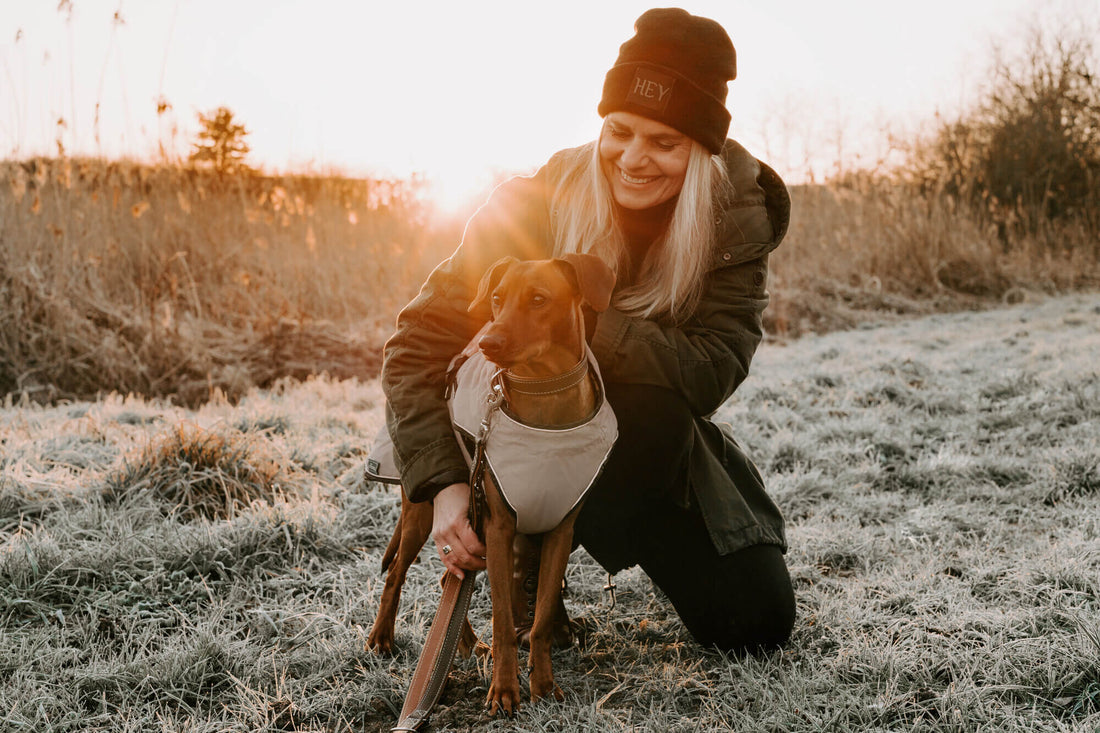As you stroll through the local park and spot a Labrador in a stylish coat or a Spaniel sporting a sleek jumper, it might be tempting to believe that canine attire is purely about keeping up with the latest doggy fashion trends. Of course, there’s a certain joy in seeing our furry mates looking dapper. But, more often than not, dressing our dogs goes beyond just the aesthetic.
Behind every well-chosen dog coat is a tale of practicality: protection from the unpredictable British weather, ensuring their utmost comfort, and considering their unique physiological needs. In this piece, we'll explore the essential reasons to dress our dogs in coats.
The Basics of Canine Body Temperature
Dog Physiology: At first glance, our four-legged friends, with their natural fur coats, might seem well-equipped to handle the UK's often brisk weather. However, it's important to recognise that dogs regulate their body temperature quite differently from us humans.
While we have sweat glands distributed throughout our skin, dogs primarily release heat through panting and a few sweat glands in their paw pads. This makes their fur crucial in the temperature regulation process, both in keeping them warm during colder months and insulated against excessive heat.
Misconceptions: One prevalent belief is that a dog’s fur is all they need to stay toasty, even in freezing conditions. Although fur does offer insulation, its effectiveness can significantly vary based on the breed, age, health, and the thickness and length of the coat. For instance, breeds with short or thin fur, like Greyhounds or Chihuahuas, can struggle in colder weather.
On the flip side, dogs with dense undercoats, such as the Alaskan Malamute, are naturally more adapted to colder climates. However, even they can benefit from extra protection during particularly harsh weather, or when their lifestyle involves prolonged exposure to the cold. The Monaco Dog Coat, for example, can offer an additional layer of warmth and protection, bridging the gap between nature's provision and our pets' actual needs.
Sign 1: Uncontrollable Shivering
Explanation: Picture this: you step out on a particularly chilly morning, and in seconds, you feel your body involuntarily shivering. Similarly, when dogs feel cold, one of their instinctual responses is to shiver. Shivering is a rapid muscle movement that generates heat to warm the body. While it's a natural mechanism, uncontrollable or prolonged shivering is an obvious sign that your dog is feeling more than just a little cold and needs some extra warmth.
Observation Tips: Recognising the difference between a little shiver after a splash in a puddle and distressing, prolonged shivering is vital. Monitor the duration and the intensity of the shivers. If you observe your dog shivering even after coming indoors or if the shivering is accompanied by other signs of distress, it's a clear indication they're feeling the cold. A well-insulated coat like the UPPSALA Thermo Dog Coat can provide the necessary warmth and protection against the biting cold, ensuring your pup stays comfortable during your outdoor escapades.
Sign 2: Reluctance to Go Outside in the Cold
Behavioural Signs: We've all seen it – that hesitant paw shuffle at the door, the longing look towards their cosy bed, or even those big puppy eyes silently pleading to stay inside. It's not just your imagination or your dog being stubborn. Dogs, much like us, have a natural aversion to discomfort. While some might express their displeasure more dramatically, others might simply stand still, refusing to budge from the warmth of the indoors.
Importance: Recognising and respecting your dog's reluctance is crucial. Forcing them out without adequate protection can expose them to the risk of hypothermia or other cold-related complications. Moreover, consistently ignoring their hesitance can lead to a stressful association with walks or outside time.
Investing in a good quality coat, such as the UPPSALA COZY Coat or the Monaco Dog Coat, can make the world of difference. They not only provide warmth but also act as a reassuring layer between your dog and the chilly outdoors, making the transition from the snug inside to the crisp outside a lot smoother.
Sign 3: Age and Health Factors
Elderly Dogs: Just as humans may feel the cold more acutely as they age, our canine companions experience similar challenges. As dogs grow older, their metabolism slows down, and they may have a harder time generating and maintaining body heat.
Their fur might thin out, and their energy levels dip, leaving them less inclined to indulge in physical activities that would otherwise keep them warm. For senior dogs, ensuring extra warmth is not just about comfort, but it's about their well-being. A coat like the UPPSALA Thermo Dog Coat is specifically designed to offer that additional warmth which older dogs might benefit from.
Health Conditions: Certain health conditions can make dogs more vulnerable to cold weather. For instance, arthritis, a common ailment in many dogs, can get exacerbated in cold conditions. The chilly weather can stiffen joints, causing discomfort or pain.
Similarly, dogs with conditions like diabetes, hormonal imbalances, or heart disease might have impaired temperature regulation. For these dogs, the protection of a high-quality coat, such as the Malmo Dog Coat, isn’t just a luxury; it's a necessity to ensure they remain comfortable and healthy during colder spells.
Sign 4: Thin Fur or Bald Spots
Different Fur Types: Not all dogs are created equal when it comes to their fur. While breeds like Huskies and Bernese Mountain Dogs sport thick, double coats designed to weather the coldest of temperatures, others such as Whippets, Greyhounds, or Chihuahuas have much thinner fur layers. For the latter, their slender bodies combined with scanty fur make them far more susceptible to feeling the chill. In Britain's unpredictable weather, these breeds will undoubtedly appreciate the added insulation from something like the Monaco Dog Coat.
The Role of Bald Spots: We might occasionally notice bald patches on our pets. These can arise from a variety of causes, such as medical treatments (like surgeries), skin conditions, allergies, or even age-related factors. These bald areas lack even the minimal protection fur provides, making them direct exposure points to the cold. In such cases, it's vital to provide these vulnerable spots with protection. The UPPSALA COZY Coat is a great choice, with its snug fit ensuring those sensitive areas are well-covered and kept warm.
Sign 5: Post-Bath Chills
The Dangers of Wet Fur: We've all felt that shiver after stepping out of a warm bath, even inside our homes. Now, imagine your canine friend, fresh out of a bath and with their fur damp. Wet fur is a poor insulator, rapidly sapping warmth from a dog's body. In the UK, where the weather can be especially cold and unpredictable, this can pose a significant risk. Dampness causes the fur to lose its insulating air pockets, leading to a dramatic drop in body temperature, making your dog feel even colder than usual.
The Solution: This is where the practicality of a dog coat truly shines. Slipping on something like the UPPSALA Thermo Dog Coat or the Malmo Dog Coat can act as a barrier against the cold, ensuring that your pet retains its body warmth even as its fur dries. Plus, for those unpredictable rainy days, having a coat at the ready means you’re equipped to combat the cold that follows a surprise downpour.
Choosing the Right Dog Coat
Factors to Consider:
Material: The material of the coat is vital for ensuring warmth and comfort. Ideally, the outer layer should be water-resistant or waterproof, especially for those rainy UK days, while the inner lining should provide insulation without causing overheating.
Size: A coat that doesn't fit is a coat that doesn't do its job. Ensure that the coat is snug, but not too tight, and covers the main body without restricting movement. Many reputable brands offer a size guide, tailored to various breeds and sizes.
Ease of Putting On: No one wants a wrestling match every time the coat needs to go on or off. Look for designs that are easy to slip on with adjustable fastenings for a secure fit.
Additional Features: Reflective stripes for nighttime walks, a hole for a lead or harness, and machine washability are just a few of the other considerations you might want to bear in mind.
Recommendations:
UPPSALA Allrounder Coat: An excellent choice for those looking for a versatile coat suitable for various conditions. Its design ensures ease of wear while offering adequate protection against the cold.
Dog Rain Coat Milford: Specifically designed for wet weather, this raincoat is not only water-resistant but also lightweight, ensuring your dog remains dry without feeling bogged down.
UPPSALA Thermo Dog Coat: This coat is a winter essential, especially designed for those freezing temperatures. Its thermal properties ensure that your dog stays warm, making it a must-have for those frosty morning walks.
While these are just a few options, always make sure to read reviews, consult size guides, and consider your dog's specific needs when making a purchase.
Conclusion
In our journey with our canine companions, their comfort and well-being should always be at the forefront. Recognising the signs that they might be cold is more than just an exercise in empathy; it's a testament to the bond we share with them. As we've explored, even in the UK's varying weather conditions, a simple accessory like a dog coat can make a significant difference in their lives. Beyond fashion or aesthetics, it's about understanding their needs and ensuring they're well-equipped to face the world by our side, come rain or shine. Always be observant, trust your instincts, and ensure that our furry friends are as snug and comfortable as they deserve to be.

